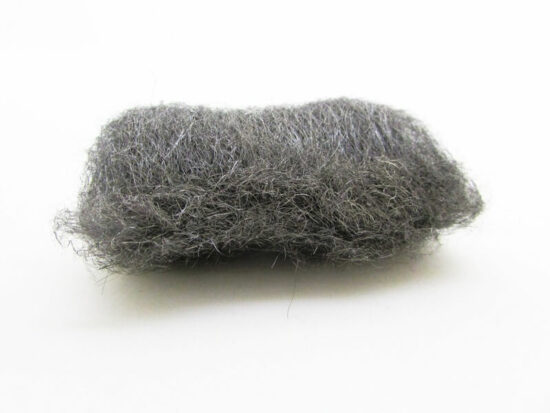Using steel wool for mice is a strategy that can be quite effective if you know what you’re doing.
This guide will teach you how to plug mouse holes with steel wool so you can keep these pests out. Plus, you’ll learn what kind of steel wool to get to stop mice from chewing through!
Table of Contents
How Effective Is Steel Wool For Mice?
There is no shortage of techniques to deal with mouse problems. These pests have bothered homeowners for eons, and humans have developed many unique ways to address infestations. From old-school snap traps to DIY methods using products you have around the house, you’ve likely tried many solutions.
But what about using steel wool for mice?
Steel wool is a product that you can easily get at your local grocery or big-box home improvement center. As the name implies, it’s a wool-like product made entirely of steel filaments. It’s predominantly used for cleaning and polishing.
- Designed to block drains, cracks in walls, ventilation holes, and more
- Our steel wool is soft, thick, and fluffy, allowing it to be easily bent and maneuvered into corners and around objects
- Can be used for both indoor and outdoor purposes
- Each roll is 3 inches wide, 15 feet long
You’ll often see it being utilized by welders and other metalworkers. However, you can also find soap-infused steel wool to clean pans and other kitchen items!
Despite all those “traditional” applications, using steel wool for mice is surprisingly effective. Why? It all comes down to the texture.
Mice are cunning little creatures that can wreak havoc on your home. They go to extreme measures to get into houses, and they don’t need very much room to wriggle their way in. Small mice can squeeze through holes that are only a quarter-inch in diameter!
Once they find a void or gap to take advantage of, the mouse will continue their destructive path into your home. They’ll chew on anything they can. That includes wires, insulation, plastic, and even wood.
But mice cannot chew through steel wool.
Some mice will attempt to eat their way through steel wool. But when they do, it’ll cause immense pain. Most mice will turn away and look for other entrance opportunities instead of attempting to get through the wool. The rodents that do eat the steel threads ultimately get sick and die.
As a result, it’s an effective mouse deterrent. When used strategically, you can use the wool to plug up any potential entrance holes and keep mice out of your house.
Expert Tip: You won’t see much impact on the mice you already have. Steel wool is strictly for keeping mice out, so you’ll need to address existing infestations first.
But once that’s done, steel wool can make a huge difference by reducing or eliminating all future infestation. It’s best utilized as a preventative measure that creates a discrete barrier. You can deter mice without resorting to other ethically questionable means.
How To Plug Mouse Holes With Steel Wool
Using steel wool to plug mouse holes is not difficult at all.
The first thing you need to do is get rid of the existing rodents. Steel wool won’t do much to get rid of the mice you already have in your home. To ensure that you’re starting with a clean slate, it’s always good to address existing infestations before tackling preventative measures.
Once you know your house is mouse-free, you can start using steel wool to plug up holes and keep these pests away. Start by doing a thorough inspection of the home. Your goal is to find all potential entrance points for mice.
Expert Tip: Even holes and gaps less than an inch wide is plenty of room for mice to wriggle their way in. Pay attention to every possible entrance.
You’re most likely to find gaps around doors and windows. Pay attention to frames and jambs. Then, look around electrical outlets and plumbing.
Other possible entrance points include chimneys, gutters, air vents, and other transitions between your home’s interior and exterior.
To use the steel wool, you’ll need to pick it apart. It’s a good idea to wear some gloves to avoid pricks and discomfort as you work. Pick the steel wool apart, gather it into a bunch that’s about the right size of the hole, and stuff it in!
- Designed to block drains, cracks in walls, ventilation holes, and more
- Our steel wool is soft, thick, and fluffy, allowing it to be easily bent and maneuvered into corners and around objects
- Can be used for both indoor and outdoor purposes
- Each roll is 3 inches wide, 15 feet long
Use pliers or a flathead screwdriver to work the steel wool into the hole. The goal is to pack it in as tightly as possible. Loose wool won’t be much of an issue for the mice. You want it packed tightly so the rodent has no choice but to attempt to chew through it.
Don’t get stingy when it comes to using steel wool for mice! Use plenty to pack the void tightly and fill all air gaps. Don’t let any light shine through!
You can leave it there and move on to your next hole. A well-packed void is usually more than enough to stop mice. Most will turn away after attempting to chew through the first time and feeling that pain.
If you want extra peace of mind, you can add a thin layer of silicone caulk. The caulk will seal the steel wool in place, preventing more cunning rodents from using their hands to pick the material out.
What Type Of Steel Wool Is Best For Mice?
The best type of steel wool to use for mice is medium grade. When you shop for steel wool, you’ll find a few different options, and the grade refers to how thick the threads are and how dense the product is.
Higher grades can be more challenging to work with, presenting a challenge as you attempt to pack the material in the voids. Meanwhile, low-grade wool is far too easy for the mice to chew through as they try to get inside your home.
Medium grade provides the right balance. It’s soft enough to shape and condense as you stuff it into a void, but it’s also hard enough to present a challenging barrier for the mice!
You can get steel wool in a few different forms, too. Stores often sell it as bundled scrubbers or rolls of padding. Either option works, but wool pads are easier to manage as you pick the wool apart.
When you choose pads, make sure they don’t have any detergent. Steel wool scouring pads are pretty common in grocery stores, but they have a soap treatment.
Getting the product wet softens it and causes foaming. It’s not the best thing to have stuffed into your walls and entryways.
Can Mice Chew Through Steel Wool?
Technically, mice can chew through just about anything. But that doesn’t mean they will!
Mice feel pain just like any animal. While they frequently use their teeth to navigate difficult surroundings and overcome obstacles, they have a limit to what they can tolerate.
Chewing on steel wool is a pretty uncomfortable experience for a mouse. Imagine what it’d feel like for you! It harms the teeth and can cause injuries that severely impact the rodent’s ability to survive.
Some mice will attempt to chew through the steel wool anyways. In rare instances, they will be successful. But a vast majority of mice can’t tolerate the pain of chewing through the wool.
They’ll attempt it once, feel the pain of the metal, and turn around to find another route inside. That’s what makes steel wool so effective. While they could try to use their teeth, it’s one material that’s not easy to get through.
The Benefits Of Using Steel Wool For Mice
There are a few benefits of using steel wool for mice.
As mentioned earlier, many mouse control methods exist. From snapping traps to poisons, you have plenty of ways to tackle a mouse problem.
Using steel wool to keep mice away is a hands-off and humane approach. It won’t do much to eliminate existing mice, but it can undoubtedly repel these pests without resorting to death and destruction.
With other methods, you’re causing pretty painful deaths. Mechanical traps break bones, sticky traps cause slow suffocation, and poisons can cause days of mass suffering. You don’t get any of that with steel wool.
Sure, mice can’t chew through steel wool because it’s painful. But the rodent has the choice to turn around and never interact with it again! It’s a way to keep them out humanely without resorting to more aggressive methods.
Plus, it’s a relatively safe option! Those other pest control methods can be hazardous if you have pets and kids. Having poison around is just asking for trouble. The same goes with painful traps.
Steel wool isn’t something your kids and pets should handle. But if you use the material correctly, they shouldn’t have to! It stays out of sight and out of mind, doing the heavy lifting to keep mice out without getting in the way.
Another benefit of steel wool for mice is that it’s affordable. You can get this stuff anywhere. It’s not easy to find, and you’ll likely have a wide range of price options. There’s no need to go with fancy brands or ultra-high-quality products.
Cheap wool does the trick just fine! It’ll serve you well if you use medium-grade wool with no soaps or chemicals. It’s an affordable alternative to pricier pest control methods, letting you adopt passive preventative measures without spending an arm and a leg. Who doesn’t want that?
Conclusion
Using steel wool for mice can be a fantastic way to plug holes and keep these pests out. As long as you get a kind they can’t move or chew through, you’ll definitely notice a difference!
If you have any questions about this method, send us a message via our contact page. We’ll respond as soon as we can.



